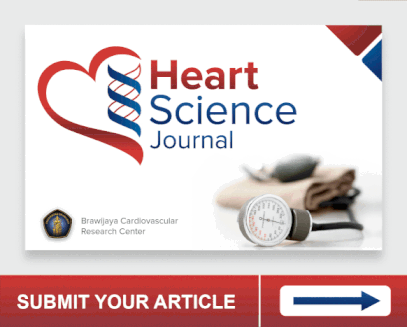Atrial Fibrillation Development Risk Associated with Metabolic Syndrome
Abstract
of AF, including growing older, being a man, being female, having high blood pressure, and having cardiac and noncardiac illnesses. Metabolic syndrome (MS) contributes to the progression of AF through its impact on the atrial substrate. MS involves metabolic risk factors that increase the likelihood of atherosclerotic cardiovascular disease and type 2 diabetes. Insulin resistance plays a significant role in MS pathophysiology, leading to glucose and lipid metabolism dysregulation, increased inflammation, and neurohormonal activation. These processes contribute to the development of hypertension, a major risk factor for AF. Atrial remodeling, including electrical and structural changes, is a common substrate for AF, and MS components further contribute to this remodeling.
Hypertension, a key feature of MS, is associated with structural, contractile, and electrical remodeling in the atria, increasing the risk of AF. The renin-angiotensin-aldosterone system, implicated in hypertension regulation, also
influences the pathophysiology of AF through fibrosis, ion channel alterations, oxidative stress, and inflammation. Understanding the intricate interplay between MS and AF can provide insights into therapeutic strategies for managing these conditions and reducing cardiovascular risks.
Keywords
Full Text:
PDFReferences
Fadlan, M. Rizki; Rizal A. The Future Direction Of Screening For Atrial Fibrillation : A Literature Review. 2022nd ed. (HSJ, ed.). Heart Science Journal; 2022.
Husniyah B, Herwanto B, Handajani NI. Characteristics of Atrial Fibrillation Based On Age, Sex, and Etiology. JUXTA J Ilm Mhs Kedokt Univ Airlangga. 2020;11(2):86. doi:10.20473/juxta.v11i22020.86-89
Kim YG, Choi KJ, Han S, et al. Metabolic syndrome and the risk of new-onset atrial fibrillation in middle-aged east Asian men. Circ J. 2018;82(7):1763-1769. doi:10.1253/circj.CJ-18-0113
Zulkifly H, Lip GYH, Lane DA. Epidemiology of atrial fibrillation. Int J Clin Pract. 2018;72(3):1-7. doi:10.1111/ijcp.13070
Kumar P, Gehi AK. Atrial fibrillation and metabolic syndrome: Understanding the connection. J Atr Fibrillation. 2012;5(3):89-97.
Nyström PK, Carlsson AC, Leander K, De Faire U, Hellenius ML, Gigante B. Obesity, metabolic syndrome and risk of atrial fibrillation: A swedish, prospective cohort study. PLoS One. 2015;10(5):1-14. doi:10.1371/journal.pone.0127111
Tadic M, Ivanovic B, Cuspidi C. What do we currently know about metabolic syndrome and atrial fibrillation? Clin Cardiol. 2013;36(11):654-662. doi:10.1002/clc.22163
Chowdhury S, Chakraborty P pratim. Universal health coverage ‑ There is more to it than meets the eye. J Fam Med Prim Care. 2017;6(2):169-170. doi:10.4103/jfmpc.jfmpc
Grundy SM, Cleeman JI, Daniels SR, et al. Diagnosis and management of the metabolic syndrome: An American Heart Association/National Heart, Lung, and Blood Institute scientific statement. Circulation. 2005;112(17):2735-2752. doi:10.1161/CIRCULATIONAHA.105.169404
Powell EE, Jonsson JR, Clouston AD. International Diabetes Federation Consensus Worlwide Definition of The Metabolic Syndrome. 2010;28(1):186-191. doi:10.1159/000282084
Kaur J. A Comprehensive Review on Metabolic Syndrome. Cardiol Res Pract. 2019;2019(5):1-1. doi:10.1155/2019/4301528
Rochlani Y, Pothineni NV, Kovelamudi S, Mehta JL. Metabolic syndrome: Pathophysiology, management, and modulation by natural compounds. Ther Adv Cardiovasc Dis. 2017;11(8):215-225. doi:10.1177/1753944717711379
Boden G, Shulman GI. Free fatty acids in obesity and type 2 diabetes: Defining their role in the development of insulin resistance and β-cell dysfunction. Eur J Clin Invest. 2002;32(SUPPL. 3):14-23. doi:10.1046/j.1365-2362.32.s3.3.x
Tooke JE, Hannemann MM. Adverse endothelial function and the insulin resistance syndrome. J Intern Med. 2000;247(4):425-431. doi:10.1046/j.1365-2796.2000.00671.x
Kaur J. A comprehensive review on metabolic syndrome. Cardiol Res Pract. 2014;2014. doi:10.1155/2014/943162
Yogita Rochlani, Naga Venkata Pothineni SK and. Metabolic syndrome: pathophysiology, management, and modulation by natural compounds Yogita. Ther Adv Vaccines. 2018;9(6):259-261. doi:10.1177/https
McCracken E, Monaghan M, Sreenivasan S. Pathophysiology of the metabolic syndrome. Clin Dermatol. 2018;36(1):14-20. doi:10.1016/j.clindermatol.2017.09.004
Iwasaki YK, Nishida K, Kato T, Nattel S. Atrial fibrillation Pathophysiology: Implications for management. Circulation. 2011;124(20):2264-2274. doi:10.1161/CIRCULATIONAHA.111.019893
Perhimpunan dokter spesialis kardiovaskular indonesia. Pedoman Tatalaksana Fibrilasi Atrium Non-valvular. PERKI. Published online 2019:54-55.
Iwasaki YK, Nishida K, Kato T, Nattel S. Atrial fibrillation pathophysiology: Implications for management. Circulation. 2011;124(20):2264-2274. doi:10.1161/CIRCULATIONAHA.111.019893
Harada M, Tadevosyan A, Qi X, et al. Atrial Fibrillation Activates AMP-Dependent Protein Kinase and its Regulation of Cellular Calcium Handling: Potential Role in Metabolic Adaptation and Prevention of Progression. J Am Coll Cardiol. 2015;66(1):47-58. doi:10.1016/j.jacc.2015.04.056
Erickson JR, Joiner M ling A, Guan X, et al. A Dynamic Pathway for Calcium-Independent Activation of CaMKII by Methionine Oxidation. Cell. 2008;133(3):462-474. doi:10.1016/j.cell.2008.02.048
Verdecchia P, Angeli F, Reboldi G. Hypertension and Atrial Fibrillation. Circ Arrhythmia Electrophysiol. Published online 2018:352-368. doi:10.1161/CIRCRESAHA.117.311402
Lau YF, Yiu KH, Siu CW, Tse HF. Hypertension and atrial fibrillation: Epidemiology, pathophysiology and therapeutic implications. J Hum Hypertens. 2012;26(10):563-569. doi:10.1038/jhh.2011.105
Savelieva I, Kakouros N, Kourliouros A, Camm AJ. Upstream therapies for management of atrial fibrillation: Review of clinical evidence and implications for European Society of Cardiology guidelines. Part I: Primary prevention. Europace. 2011;13(3):308-328. doi:10.1093/europace/eur002
Ehrlich JR, Hohnloser SH, Mattel S. Role of angiotensin system and effects of its inhibition in atrial fibrillation: Clinical and experimental evidence. Eur Heart J. 2006;27(5):512-518. doi:10.1093/eurheartj/ehi668
Lau Y, Yiu K, Siu C, Tse H. Hypertension and atrial fibrillation : epidemiology , pathophysiology and therapeutic implications. 2011;26(10):563-569. doi:10.1038/jhh.2011.105
Seyed Ahmadi S, Svensson AM, Pivodic A, Rosengren A, Lind M. Risk of atrial fibrillation in persons with type 2 diabetes and the excess risk in relation to glycaemic control and renal function: A Swedish cohort study. Cardiovasc Diabetol. 2020;19(1):1-12. doi:10.1186/s12933-019-0983-1
Wang A, Green JB, Halperin JL, Piccini JP. Atrial Fibrillation and Diabetes Mellitus: JACC Review Topic of the Week. J Am Coll Cardiol. 2019;74(8):1107-1115. doi:10.1016/j.jacc.2019.07.020
Huxley RR, Alonso A, Lopez FL, et al. Type 2 diabetes, glucose homeostasis and incident atrial fibrillation: The Atherosclerosis risk in communities study. Heart. 2012;98(2):133-138. doi:10.1136/heartjnl-2011-300503
Ko SH, Park YM, Yun JS, et al. Severe hypoglycemia is a risk factor for atrial fibrillation in type 2 diabetes mellitus: Nationwide population-based cohort study. J Diabetes Complications. 2018;32(2):157-163. doi:10.1016/j.jdiacomp.2017.09.009
Gami AS, Hodge DO, Herges RM, et al. Obstructive Sleep Apnea, Obesity, and the Risk of Incident Atrial Fibrillation. J Am Coll Cardiol. 2007;49(5):565-571. doi:10.1016/j.jacc.2006.08.060
Wang A, Green JB, Halperin JL, Piccini JP. Atrial Fibrillation and Diabetes Mellitus: JACC Review Topic of the Week. J Am Coll Cardiol. 2019;74(8):1107-1115. doi:10.1016/j.jacc.2019.07.020
Javed S, Gupta D, Lip GYH. Obesity and atrial fibrillation: Making inroads through fat. Eur Hear J - Cardiovasc Pharmacother. 2021;7(1):59-67. doi:10.1093/ehjcvp/pvaa013
Lin YK, Chen YJ, Chen SA. Potential atrial arrhythmogenicity of adipocytes: Implications for the genesis of atrial fibrillation. Med Hypotheses. 2010;74(6):1026-1029. doi:10.1016/j.mehy.2010.01.004
Sarzani R, Salvi F, Dessì-Fulgheri P, Rappelli A. Renin-angiotensin system, natriuretic peptides, obesity, metabolic syndrome, and hypertension: An integrated view in humans. J Hypertens. 2008;26(5):831-843. doi:10.1097/HJH.0b013e3282f624a0
Ito K, Date T, Kawai M, et al. Morphological change of left atrium in obese individuals. Int J Cardiol. 2011;152(1):117-119. doi:10.1016/j.ijcard.2011.07.037
Munger TM, Dong YX, Masaki M, et al. Electrophysiological and hemodynamic characteristics associated with obesity in patients with atrial fibrillation. J Am Coll Cardiol. 2012;60(9):851-860. doi:10.1016/j.jacc.2012.03.042
Watanabe H, Tanabe N, Yagihara N, Watanabe T, Aizawa Y, Kodama M. Association between lipid profile and risk of atrial fibrillation: Niigata preventive medicine study. Circ J. 2011;75(12):2767-2774. doi:10.1253/circj.CJ-11-0780
Bang CN, Greve AM, Abdulla J, Køber L, Gislason GH, Wachtell K. The preventive effect of statin therapy on new-onset and recurrent atrial fibrillation in patients not undergoing invasive cardiac interventions: A systematic review and meta-analysis. Int J Cardiol. 2013;167(3):624-630. doi:10.1016/j.ijcard.2012.08.056
Coates DR, Chin JM, Chung STL. Blood Lipid Levels, Lipid Lowering Medications, and the Incidence of Atrial Fibrillation: The Atherosclerosis Risk in Communities (ARIC) Study. Bone. 2011;23(1):1-7. doi:10.1161/CIRCEP.111.966804.Blood
Díaz-Peromingo JA, Albán-Salgado A, García-Suárez F, Sánchez-Leira J, Saborido-Froján J, Iglesias-Gallego M. Lipoprotein(a) and lipid profile in patients with atrial fibrillation. Med Sci Monit. 2006;12(3):122-125.
Miller M, Stone NJ, Ballantyne C, et al. Triglycerides and cardiovascular disease: A scientific statement from the American Heart Association. Circulation. 2011;123(20):2292-2333. doi:10.1161/CIR.0b013e3182160726
Hindricks G, Potpara T, Dagres N, et al. 2020 ESC Guidelines for the diagnosis and management of atrial fibrillation developed in collaboration with the European Association for Cardio-Thoracic Surgery (EACTS). Eur Heart J. 2021;42(5):373-498. doi:10.1093/eurheartj/ehaa612
Chung MK, Refaat M, Shen WK, et al. Atrial Fibrillation: JACC Council Perspectives. J Am Coll Cardiol. 2020;75(14):1689-1713. doi:10.1016/j.jacc.2020.02.025
Pathak RK, Middeldorp ME, Meredith M, et al. Long-term effect of goal-directed weight management in an atrial fibrillation cohort: A long-term follow-up study (LEGACY). J Am Coll Cardiol. 2015;65(20):2159-2169. doi:10.1016/j.jacc.2015.03.002
Dorian P, Singh BN. Upstream therapies to prevent atrial fibrillation. Eur Hear Journal, Suppl. 2008;10(H). doi:10.1093/eurheartj/sun033
Kanamori H, Takemura G, Goto K, et al. Resveratrol reverses remodeling in hearts with large, old myocardial infarctions through enhanced autophagy-activating AMP kinase pathway. Am J Pathol. 2013;182(3):701-713. doi:10.1016/j.ajpath.2012.11.009
Baczko I, Liknes D, Yang W, et al. Characterization of a novel multifunctional resveratrol derivative for the treatment of atrial fibrillation. Br J Pharmacol. 2014;171(1):92-106. doi:10.1111/bph.12409
DOI: https://doi.org/10.21776/ub.hsj.2023.004.03.2
Refbacks
- There are currently no refbacks.
Copyright (c) 2023 Fandy Hazzy Alfata, Ardian Rizal, Mohammad Saifur Rohman, Anna Fuji Rahimah

This work is licensed under a Creative Commons Attribution 4.0 International License.









